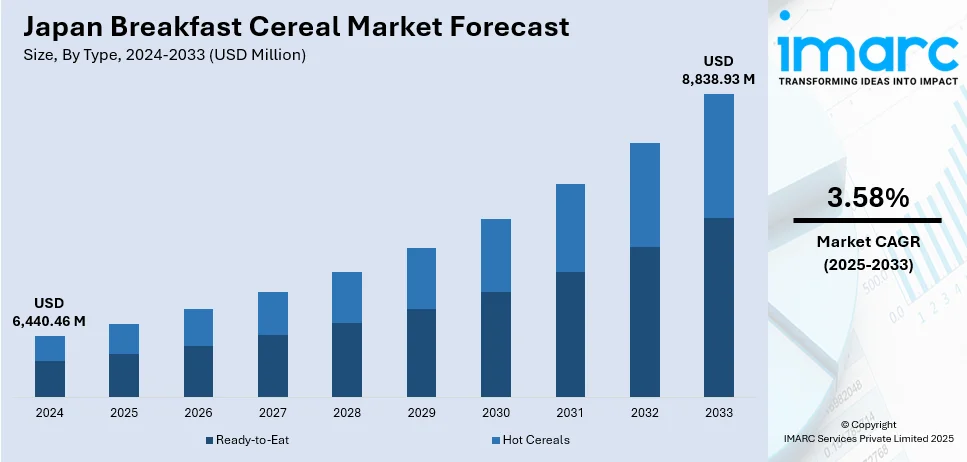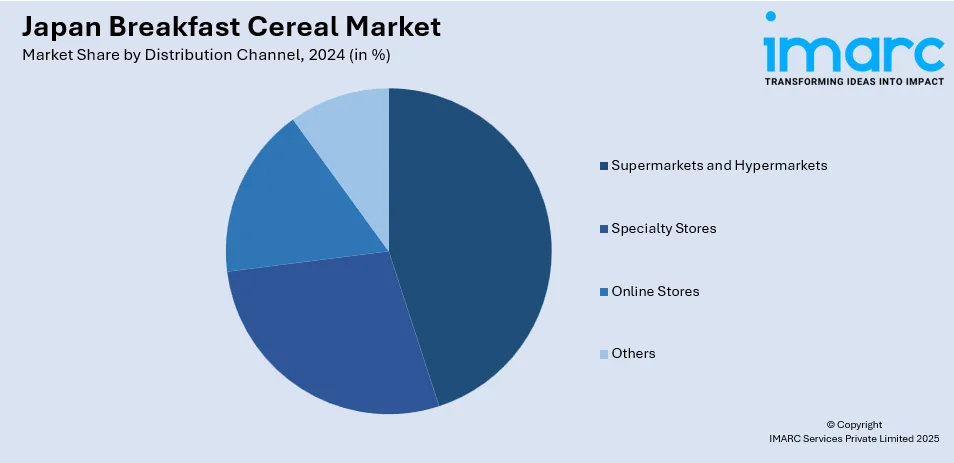
Japan Breakfast Cereal Market Size, Share, Trends and Forecast by Type, Nature, Distribution Channel, and Region, 2025-2033
Japan Breakfast Cereal Market Overview:
The Japan breakfast cereal market size reached USD 6,440.46 Million in 2024. Looking forward, IMARC Group expects the market to reach USD 8,838.93 Million by 2033, exhibiting a growth rate (CAGR) of 3.58% during 2025-2033. The market is supported by growing health awareness, where consumers are opting for functional and nutrition-fortified products supporting health and long life. Blending traditional Japanese ingredients such as matcha and kinako also appeals local taste profiles, boosting acceptability. While time and urban lifestyle constraints are driving demand for ready-to-consume, easy breakfast solutions, the growth of online grocery stores and e-commerce is making cereals more affordable, particularly among younger consumers. All these factors are contributing to increase the Japan breakfast cereal market share.
|
Report Attribute
|
Key Statistics
|
|---|---|
|
Base Year
|
2024 |
|
Forecast Years
|
2025-2033
|
|
Historical Years
|
2019-2024
|
| Market Size in 2024 | USD 6,440.46 Million |
| Market Forecast in 2033 | USD 8,838.93 Million |
| Market Growth Rate 2025-2033 | 3.58% |
Japan Breakfast Cereal Market Trends:
Incorporation of Local Traditional Ingredients
Breakfast cereals in Japan are now including traditional local ingredients to suit local tastes and preferences. Companies are mixing Western-style cereals with Japanese flavors like matcha (green tea), kinako (roasted soybean flour), and yuzu (citrus fruit) extracts. This blending satisfies the cultural taste of Japanese consumers and also makes products stand out in a competitive market. Through these integrated familiar flavors, brands are aiming to create a unique sensory experience through their cereals, in order to make them more desirable to local consumers who enjoy the mix of tradition and innovation. This trend is part of a larger movement toward regionalizing product offerings to ensure that global products are attuned to local palates and eating cultures.

Focus on Functional and Enriched Cereals
In Japan, consumers are looking for breakfast cereals that bring benefits that go beyond simple nutrition. Food companies are hence sourcing products containing additional functional nutrients such as probiotics, dietary fibre, and vitamins to boost the health of digestion, the immune system, and overall health. This is stimulating companies to break new ground in creating cereals that fulfill such health-orientated consumer tastes. For example, plant-based protein-enriched cereals or those that support weight management are becoming increasingly popular. This trend is consistent with Japan's overall emphasis on health and longevity, which affects food choices and stimulates the creation of functional food products in the breakfast cereal category.
Rise of E-commerce and Online Retail Channels
The convenience of online shopping is revolutionizing Japanese consumers' purchase behavior for breakfast cereals. E-commerce and online stores are becoming increasingly popular, offering a wide range of cereal products with the added benefits of home delivery and detailed product information. According to the IMARC Group, the Japan e-commerce market size reached USD 258.0 Billion in 2024, and is further expected to reach USD 692.8 Billion by 2033, exhibiting a growth rate (CAGR) of 11.02% during 2025-2033. This shift is particularly appealing to busy urban dwellers who value convenience and time-saving solutions. Manufacturers and retailers are responding by enhancing their online presence, offering exclusive online promotions, and providing detailed nutritional information to attract health-conscious consumers. The growth of internet retail channels is also increasing the distribution of breakfast cereal brands while responding to changing shopping patterns among Japanese consumers in the digital era. This shift further fuels the Japan breakfast cereal market growth.
Japan Breakfast Cereal Market Segmentation:
IMARC Group provides an analysis of the key trends in each segment of the market, along with forecasts at the country and regional levels for 2025-2033. Our report has categorized the market based on type, nature, and distribution channel.
Type Insights:
- Ready-to-Eat
- Hot Cereals
The report has provided a detailed breakup and analysis of the market based on the type. This includes ready-to-eat and hot cereals.
Nature Insights:
- Conventional
- Organic
The report has provided a detailed breakup and analysis of the market based on the nature. This includes conventional and organic.
Distribution Channel Insights:

- Supermarkets and Hypermarkets
- Specialty Stores
- Online Stores
- Others
The report has provided a detailed breakup and analysis of the market based on the distribution channel. This includes supermarkets and hypermarkets, specialty stores, online stores, and others.
Regional Insights:
- Kanto Region
- Kansai/Kinki Region
- Central /Chubu Region
- Kyushu-Okinawa Region
- Tohoku Region
- Chugoku Region
- Hokkaido Region
- Shikoku Region
The report has also provided a comprehensive analysis of all the major regional markets, which include Kanto Region, Kansai/Kinki Region, Central /Chubu Region, Kyushu-Okinawa Region, Tohoku Region, Chugoku Region, Hokkaido Region, and Shikoku Region.
Competitive Landscape:
The market research report has also provided a comprehensive analysis of the competitive landscape. Competitive analysis such as market structure, key player positioning, top winning strategies, competitive dashboard, and company evaluation quadrant has been covered in the report. Also, detailed profiles of all major companies have been provided.
Japan Breakfast Cereal Market News:
- In July 2023, Kellogg’s Japan and Kirin Holdings recently collaborated to create a functional food with ‘double health claims’ that also acts as a replacement for meals. This creation is an attempt to address the need for products that enhance intestinal health while also offering immune assistance.
Japan Breakfast Cereal Market Report Coverage:
| Report Features | Details |
|---|---|
| Base Year of the Analysis | 2024 |
| Historical Period | 2019-2024 |
| Forecast Period | 2025-2033 |
| Units | Million USD |
| Scope of the Report |
Exploration of Historical Trends and Market Outlook, Industry Catalysts and Challenges, Segment-Wise Historical and Future Market Assessment:
|
| Types Covered | Ready-to-Eat, Hot Cereals |
| Natures Covered | Conventional, Organic |
| Distribution Channels Covered | Supermarkets and Hypermarkets, Specialty Stores, Online Stores, Others |
| Regions Covered | Kanto Region, Kansai/Kinki Region, Central /Chubu Region, Kyushu-Okinawa Region, Tohoku Region, Chugoku Region, Hokkaido Region, Shikoku Region |
| Customization Scope | 10% Free Customization |
| Post-Sale Analyst Support | 10-12 Weeks |
| Delivery Format | PDF and Excel through Email (We can also provide the editable version of the report in PPT/Word format on special request) |
Key Questions Answered in This Report:
- How has the Japan breakfast cereal market performed so far and how will it perform in the coming years?
- What is the breakup of the Japan breakfast cereal market on the basis of type?
- What is the breakup of the Japan breakfast cereal market on the basis of nature?
- What is the breakup of the Japan breakfast cereal market on the basis of distribution channel?
- What is the breakup of the Japan breakfast cereal market on the basis of region?
- What are the various stages in the value chain of the Japan breakfast cereal market?
- What are the key driving factors and challenges in the Japan breakfast cereal market?
- What is the structure of the Japan breakfast cereal market and who are the key players?
- What is the degree of competition in the Japan breakfast cereal market?
Key Benefits for Stakeholders:
- IMARC’s industry report offers a comprehensive quantitative analysis of various market segments, historical and current market trends, market forecasts, and dynamics of the Japan breakfast cereal market from 2019-2033.
- The research report provides the latest information on the market drivers, challenges, and opportunities in the Japan breakfast cereal market.
- Porter's five forces analysis assist stakeholders in assessing the impact of new entrants, competitive rivalry, supplier power, buyer power, and the threat of substitution. It helps stakeholders to analyze the level of competition within the Japan breakfast cereal industry and its attractiveness.
- Competitive landscape allows stakeholders to understand their competitive environment and provides an insight into the current positions of key players in the market.
Need more help?
- Speak to our experienced analysts for insights on the current market scenarios.
- Include additional segments and countries to customize the report as per your requirement.
- Gain an unparalleled competitive advantage in your domain by understanding how to utilize the report and positively impacting your operations and revenue.
- For further assistance, please connect with our analysts.
 Request Customization
Request Customization
 Speak to an Analyst
Speak to an Analyst
 Request Brochure
Request Brochure
 Inquire Before Buying
Inquire Before Buying




.webp)




.webp)












